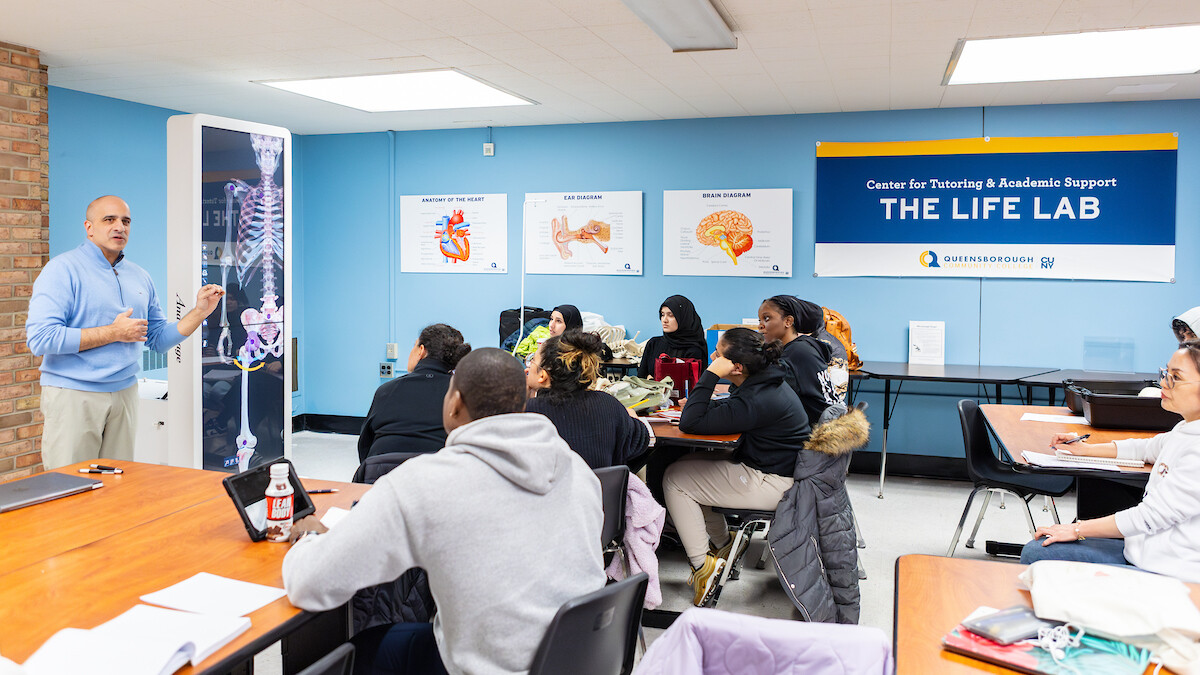More than Skin Deep: Digital Cadavers Provides Three-Dimensional Study and Dissection for Nursing and Health Sciences Students

At the front of the Life Lab inside the Center for Tutoring and Academic Support stands the Anatomage Table, a seven-foot-tall black screen, reminiscent of the alien monolith in the movie, 2001: A Space Odyssey.
Nursing and health sciences students gathered around this vertical screen which can also swivel to a table. The instructor, who, like a conductor waiving his baton, touched the screen, revealing a digital skeleton of a cadaver. That day the class studied the humerus, scapula, radius, and thoracic wall. Soon the focus will be digitized organs.
“The five Anatomage Table cadavers are all unique indviduals that afford our students the opportunity to compare the same anatomical structures in people of different ages, biological sexes, and pathologies. In addition to the diversity, students appreciate the anatomical similarities that bind humans together as created by mother nature herself,” said Dr. David Sacrestano, adjunct professor in the Department of Biological and Geological Sciences since fall 2018. In addition to instructing anatomy and physiology labs, Dr. Sacrestano is a practicing podiatric physician and surgeon in the Great Neck and area, and local hospitals.
This equipment, he says, is becoming a standard teaching tool at all nursing and medical schools, as well as select high schools, irrespective of their use of actual cadavers.
Dr. Sacrestano went on to explain that unlike ‘real’ cadavers, which degrade over time with use, digital cadavers are timeless so can be referred to and studied for years by students. “This is a critical teaching aid for nursing and health sciences students and will give them a great advantage in their pre-health, and massage-therapy curricula."
Mekahla Simpson, a first-year nursing student in the Dual/Joint Nursing program with York College, is amazed by the capability of the Anatomage. “I am a visual learner, and this equipment has helped me immensely in understanding the complexities of the human body. Right now, I am focused on the heart and when I touch the screen a large pumping heart appears. I can zoom in and see the ventricles, aorta, and pulmonary valve. I can even see how certain foods such as salt affect the heart rhythm.”
An international student, Mekahla came to the U.S. in 2022 to live with her aunt in Queens. She had attended The University of West Indies in her home country of Jamaica where she studied social work, then transferred to Queensborough after one year to pursue her dream of becoming a nurse.
The Anatomage Table equipment was purchased under the “Strengthening Career and Technical Education for the 21st Century Act” (Perkins V) Grant. The Perkins Grant supports students in Career and Technical Education majors. At Queensborough, this means all the A.A.S. degrees and some of the A.S. and Dual/joint programs --including Massage Therapy, Health Sciences and Nursing. Students in these majors take anatomy and physiology.
Giuseppina Stigler, MS Ed., Perkins Grant Director at Queensborough, was a fellow in the 2022 NextLevel Postsecondary CTE Leadership Fellowship, sponsored by ECMC and powered by ACTE. While a fellow, she conducted a site visit at Manatee Community College in Bradenton, Florida where instructors demonstrated the Anatomage Table. She returned to Queensborough to speak with Arthur Corradetti, Ph.D., Dean for Institutional Effectiveness about the idea that this equipment would take learning to the next level for nursing and health sciences students who are visual or hands on learners.
Dr. Corradetti said, “The Anatomage Table is a considerable addition to the resources of the Life Lab. A&P and other students will find it an invaluable visual aid in their studies.”
The current grant year, which started July 1, 2023, through June 30, 2024, exceeds one million dollars and will be renewed annually based on qualification and need. The grant includes the cost of the Table, career and technical education specialists, supplies, and related equipment.
“Witnessing the wonder and smiles on students' faces when they first see a cadaver and can quickly and easily dissect down towards deeper structures on the Anatomage Table is so rewarding to me as an educator. I am excited to be able to use it as a teaching resource. Moreover, I find it fascinating and valuable to study as a healthcare provider myself,” said Dr. Sacrestano. “We must remember that these cadavers were once real people with real lives, and as we would with actual cadavers, we treat them with respect and gratitude.”
The Life Lab inside the Center for Tutoring and Academic Support hours are 10-7 Monday to Thursday and Friday from 10:00am-3:00pm. Reservations and supervision by an instructor or tutor are required for use of the Anatomage Table. Call 718-631-6660 for more information.
###



